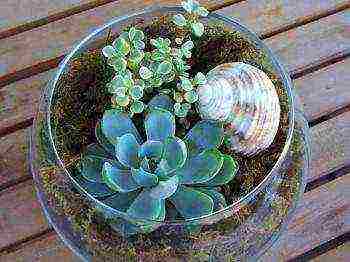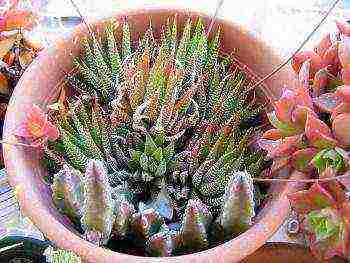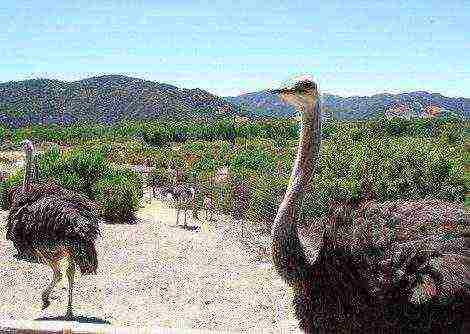Content
Reading time: 3 minutes
Many growers love succulents. They are versatile and carry the beauty of pristine nature. In addition, they make excellent flower arrangements that will stand for more than one year and do not require special care... The main thing is to provide the plant with good drainage, a small amount of moisture and protect it from frost.
But there is one unpleasant thing. Sometimes, it is difficult to find the right varieties at an affordable price. The most unusual varieties come from Asia and usually come to us in a terrible state. Therefore, growing these flowers from seeds - the best way to breed rare varieties... We have prepared a small guide to growing succulents from seeds and posted it below. Read on.
Before sowing
Before you start planting, you need to purchase small planting trays with a lot of holes; this will allow moisture to drain quickly... Please see the photo below, it is in these trays that it is best to germinate and plant the seeds of succulents and cacti.
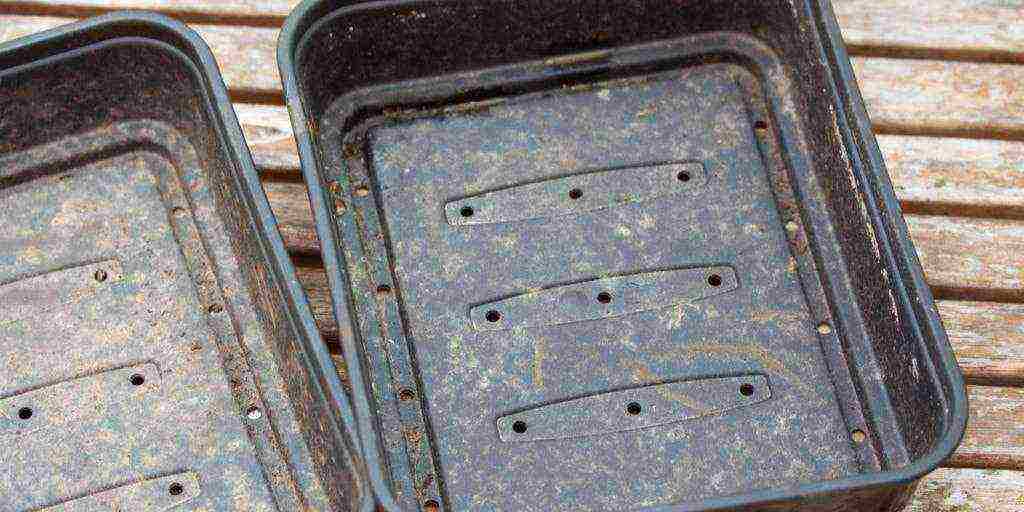
Excellent seed trays
Soil preparation
As soon as the seeds have arrived and you have prepared everything you need for planting, need to find clean sand... The sand that is sold in garden shops may contain fungicides or herbicides. That is why it is best to use construction sand, which is mixed with cement.
Small pieces of rock create small air pockets and ensure good root development.
The best advice we can give, is that you need to wet the sand well before sowing the seeds. Succulent seeds are tiny in size and therefore rinse off easily when watering. But if the soil is wet, they will stick to it and stay in place until they have roots.
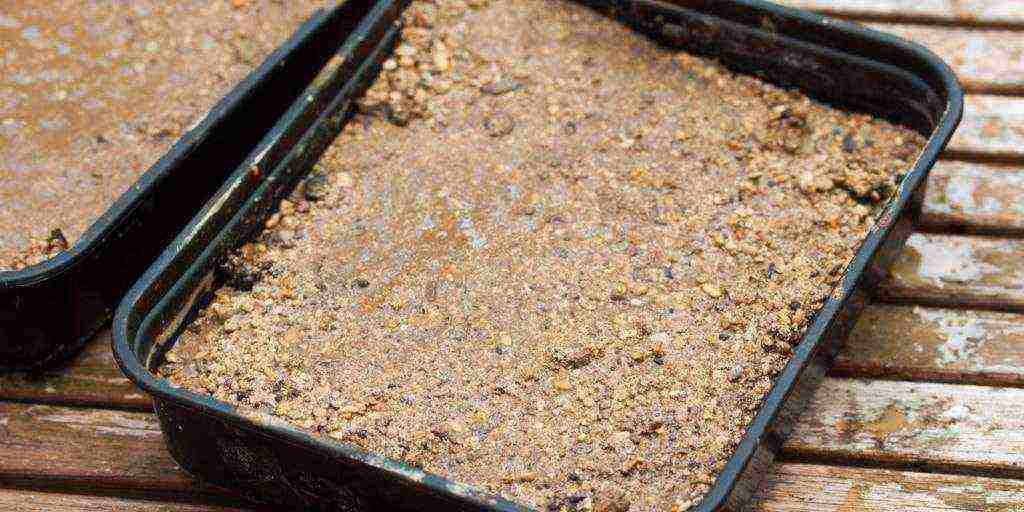
Suitable substrate for the germination of succulents
Planting seeds
To give a complete picture of growing succulents from seeds at home, we must show you what seeds look like. They are really tiny... Any gust of wind can blow them away, so it is very important to land in a protected location. The easiest way to plant seeds is to place them in the palm of your hand and gently pour the seeds into the tray.

This is what the seeds of these flowers look like.
Most importantly, make sure there is a small space between the seeds. Then lightly tap the bottom of the tray on a flat surface. By doing this, you can ensure that any seeds that have not adhered to the sand have found their place. Cover the tray with plastic wrap or a bag... This is very important as most seeds will not germinate if there is not enough moisture in the air.
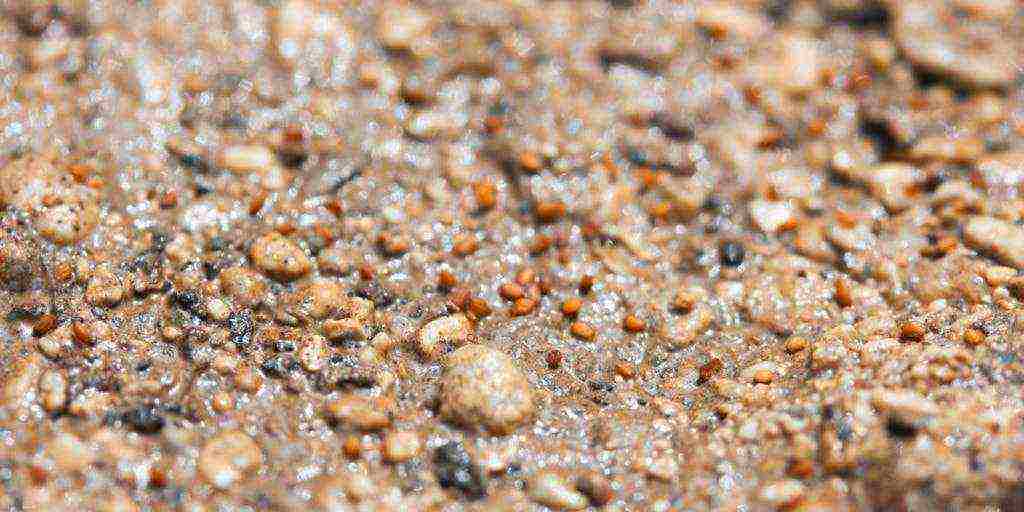
Planting seeds in the ground
The emergence of sprouts
Depending on the type of plant, germination time can vary from a few days to a couple of weeks. As you can see below, the sprouts are as small as the seeds, so it will take another week or so of stable moisture before you can let the substrate dry.
Do not forget to remove the plastic that you covered the tray with after the sprouts have emerged. Too much moisture will cause them to rot.

The first shoots appeared
Watering
To highlight how tiny they are, see the sprout and finger photo. That is why be careful - do not wet the soil too much... The best way to grow a healthy plant is to wait until all the sand is dry and then water it abundantly. Make sure the soil is completely dry between waterings.

Sprout size
To water the flowers without damaging them, you need to pour water into the corners of the tray. Check that the water drains from the drainage holes: the sand should be wet, but the plants should not sit in the water. You can move the tray to the sink so that all excess moisture is immediately drained.
Sand must dry between waterings... This will simulate the conditions of their natural habitat - the desert. After a few weeks, the sprouts develop into small plants. But if you are tempted to transplant them into another container, it is better to wait and let them grow even more.
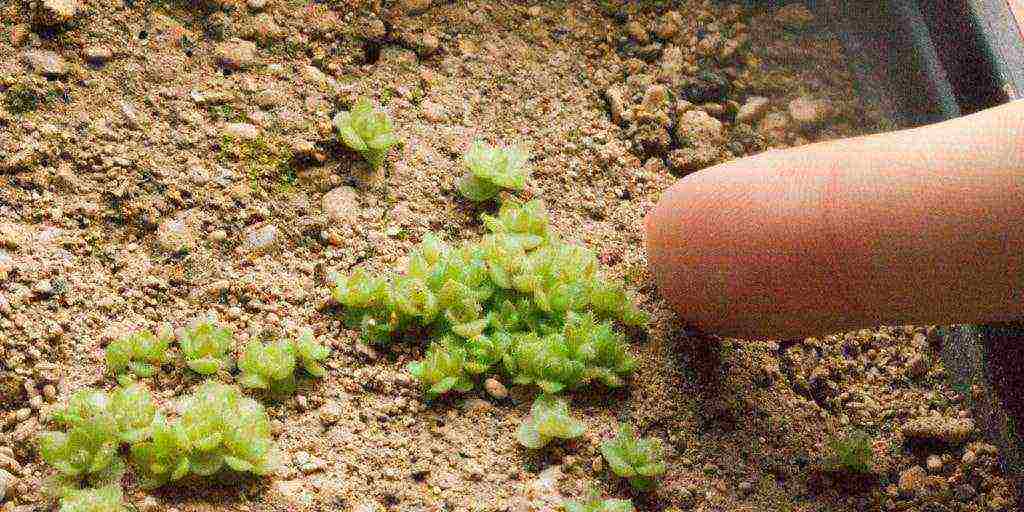
Several weeks have passed
If you manage to keep them for three months, you will have a whole group of small Succulents. Please be aware that these are desert flowers... Therefore, they do not grow as fast as other plants.
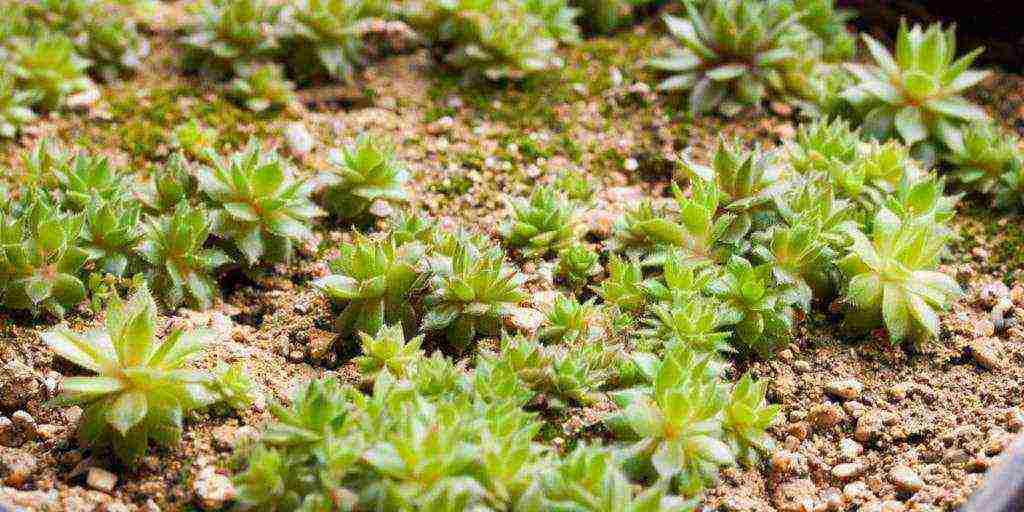
Small plants
You can grow a whole family of plants. Perhaps it makes sense to start breeding them? People will be happy to buy them, because many believe that succulents cannot be grown from seeds. In three months, flowers can reach sizes from 1 to 2.5 centimeters.
It may sound slow, but there is an explanation for this. In the area where these plants grow, there is low humidity and a harsh climate, as well as, in most cases, a small amount of nutrients. They had to adapt and use limited resources to grow.
They have adapted by developing thick leaves and stems that withstand harsh climates and maintain a slow but steady growth rate. There are also positive aspects to this: they do not need frequent transplants... Therefore, an adult plant can grow in one pot for decades (if you care for it, of course).
For more information on planting various groups of succulents, see the video below:
If you are reading this article, you are probably already in love with this beautiful group of plants - succulents. Not surprising, because they perfectly decorate any room, and are famous for a variety of colors and shapes. Many had Aloe growing up in their home since childhood, and now we have the opportunity to replenish our home collections with more rare and interesting specimens.
Growing from seeds
Sowing by seeds is the most common type of plant cultivation for many years. Fans of succulents, for sure, want to buy something new in their collection, something special, rare, unusual, at an affordable price.
For this, sowing of seeds is often used, which can now be easily purchased in online stores, such as "Kaktusenok" or Aliexpress (review on seeds from Aliexpress), having received new friends by mail. Having learned the basic principles of sowing and care, it is quite possible to grow many healthy, strong plants on your own at home.
It will be very interesting for you to watch the germination and development of the seeds of these wonderful plants. You will be able to select for yourself the most interesting specimens of seedlings, thereby replenishing the collection.

How to plant and grow a succulent plant from seeds at home? Our recommendations and photos will help you in this exciting activity. It is necessary to take into account a number of features such as:
Selecting a container for sowing
You will need shallow (about 50mm high) plastic containers with holes at the bottom and transparent lids. You can make one greenhouse out of a large box with a lid, or cover it with plastic wrap by placing several small boxes with substrate and seeds there. The stores sell suitable greenhouses, but you can use a regular plastic container, the main thing is not to forget about the holes in the bottom of the container.
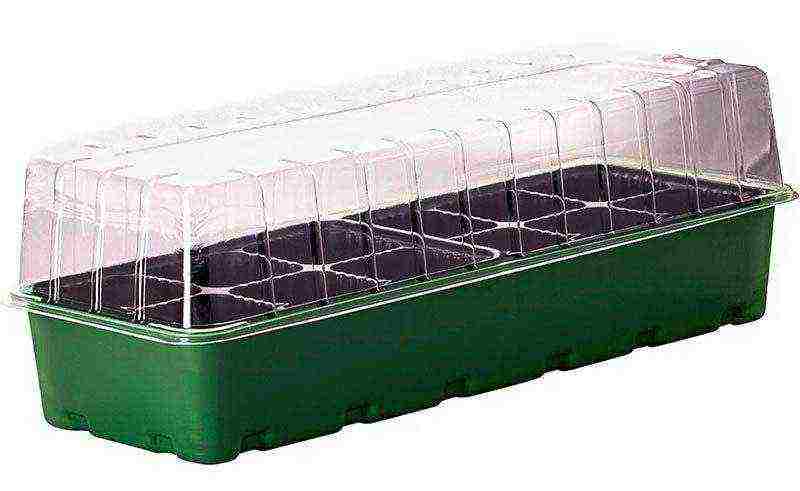
The soil
- Conventional mixtures containing a coarse mineral base are suitable, such as sand, agroperlite, fine gravel, you can also add a little crushed or granular coal.
- You can purchase a universal peat filler - slightly acidic humus and add sand, crushed coal, and perlite to it in equal proportions.
- For the preparation of the sown land, it is better to use quality ingredients purchased from specialized stores. If you want to take sand, gravel or coal from a garden or forest, you need to thoroughly treat everything with a disinfectant solution, steam it or fry it.
If the seeds are large, they can be sown into granite chips or gravel and sand. Sowing seeds in purely mineral substrates reduces the likelihood of seedlings dying from decay in the first couple of months of their life. But in this case, you need to water the seedlings almost every day, applying special fertilizers.
Succulents such as Aloe, Haworthia and Gasteria are great for sowing on pure perlite. Perlite has a high moisture capacity and breathability. But don't forget that there are no nutrients in such a substrate. Before sowing, perlite should be well moistened with water.

Sowing seeds
For even distribution of seeds, it is recommended to take a thick sheet of paper, bend it in half, and pour the seeds into it, then tap it with a thin stick or needle and scatter it into the substrate. Change is sown on top of the substrate, covered from above with a mixture of earth or a small layer of coarse sand, about 2 mm. The sprinkled layer should not be thicker than the size of the seed itself, therefore, if the seeds are very small, for example, like a ficus, then it is better not to sprinkle them at all.
Do not forget to make plastic tags indicating the type of your plants, thanks to which you can always find out the name of your friend, and clarify recommendations for his care.
From above we water with a small amount of filtered water at room temperature (you need to water it with a spray bottle), by spraying, so as not to erode the soil with seeds, and prevent seeds from penetrating into the depths of the earth. Next, cover with a lid or foil. You need to cover the greenhouse before the seeds germinate and after, as long as the plants get a little stronger and reach a size of 1-2 cm.Then we gradually stop covering.
Seed germination varies over time for different species. So the seeds of the families Agavaceae and Liliaceae germinate faster, while Apocynaceae and Asclepiadacea have a long germination time, sometimes up to three months.
All this time, the seeds should be in moist soil, and only after 60-90 days they will begin to hatch. Therefore, you should not stop watering, thinking that the seeds were bad. Higher germination is observed in freshly harvested seeds.
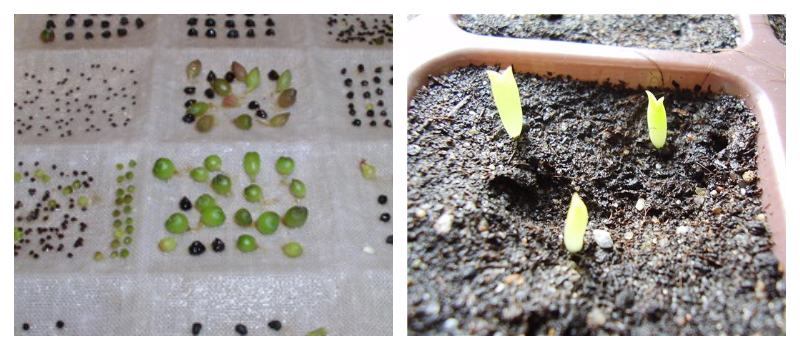
Sowing care
To get maximum germination, you need to consider factors such as temperature, lighting and watering:
- Optimal temperature for seeds in the daytime +20 - 26 degrees, the greenhouse should not be in the open sun. In summer, the temperature is up to + 30 degrees during the day, and + 18-20 degrees at night. At night, the seeds need to rest from daytime temperatures. Drafts should also be avoided.
Seeds of Havortia and Dioscorea need a temperature of + 18-20 degrees for germination. It is better to sow them in winter or early spring, so that the seeds germinate in optimal conditions, and in the summer they can gain strength and grow stronger.
If you want to plant seeds all year round, you will need to install a greenhouse and special lighting.
- Lighting good is required, but direct sunlight should be avoided, which can harm delicate, immature plants. If during the summer young shoots do not have time to get stronger, and to reach the size suitable for a comfortable life in winter (2-5 cm), it is recommended to use phytolamps to extend the growing season.
- Watering the substrate should be regular, the soil should not be allowed to dry out completely, but the water should not stagnate either. It is best to water a little as the top layer dries and sometimes leave it on for a couple of days to dry the bottom soil. Special attention to watering is required in the first year of life. The first couple of months, the soil should not be allowed to dry out for a day or more.Then you can gradually teach the young plant to dry out the soil. In summer we water more often, in winter a little less often.
As you grow, you can plant seedlings in pots. A plant with a height of 2-5 cm, which has several strengthened leaves, is ready for transplanting (Read about how to transplant a succulent in this article). The amount of water for watering one independent plant is about 3-4 ml. It is convenient to use a syringe for these purposes.
 Grown plants are ready for transplanting. Photo taken from the site and disease prevention
Grown plants are ready for transplanting. Photo taken from the site and disease prevention
For medicinal purposes, and for the prevention of seedling diseases, fungicides can be used (Vitaros, Maxim). It is necessary to breed them following the instructions. Insecticides are also used, but only liquid, low concentration. If you use nutritious soils, then additional fertilization is not needed in the first six months. If the soil is completely organic, special fertilizers for cacti and succulents are suitable, clearly according to the instructions.

Propagation by cuttings and leaves
Not all succulent lovers know that these beautiful plants reproduce not only by seeds, but also by leaves, stem cuttings, children, which, subject to the necessary requirements and care rules, germinate well and quickly form into an independent plant. Do you want to expand your collection, or donate a succulent plant, saving money? You have a great opportunity to gain experience in this business.
Where to start breeding succulents
So, a leaf or a stalk of a succulent, how to get it and germinate it. Where do we start:
It must be remembered that succulents with thick fleshy leaves (for example, Sedum, sedum, Echeveria, Crassula) reproduce in a leaf way, and only species with thin leaves (Adenium, Pachypodium, Euphorbia) are propagated by cuttings.
Sheet preparation
- You will need an adult healthy plant, the leaf or stalk should not have damage, or external signs of the disease (dryness, spots, rot).
- You need to take a very sharp knife or blade and be sure to disinfect.
- Carefully cut off the leaf or stalk at the base of the stem.
- It is forbidden immediately plant leaves and cuttings in the ground or put in water. The leaf cut must be dried within two days under normal room conditions.
Leaf with dried cut ready for rooting
Preparing and planting the cuttings
- Stalk it is recommended to treat it with crushed coal at the cut site, and if milky juice is released, rinse it off with clean water and then process it, and then dry it in the same way under normal room conditions. And then, germinate in boiled or filtered water at room temperature (it is important that the cut does not touch the bottom of the germination vessel), or in fine-grained disinfected sand, setting the stalk 1.5-2 cm and fixing it on top with fine expanded clay. After planting in the sand, it is necessary to water the cutting well with filtered (settled) water at room temperature.
- The room temperature for successful germination and rooting should be maintained around 23-25 degrees. Tolstnyanka and Euphorbia are well suited for water rooting, but Sansevieria root better in sand. For cuttings, you can use rooting stimulants (Kornevit, Epinom) following the instructions.

The soil
- Preparing the soil for rooting a leaf: you need to take a ready-made substrate from the store, for cacti and succulents, and mix a small amount of sand, fine expanded clay or crushed coal into it. Can be rooted in clean sand. All planting materials must be decontaminated. You can also add coconut substrate.
- After drying, the leaf should be placed on the prepared dry soil, at a slight angle to facilitate rooting.
 Correct rooting leaf position
Correct rooting leaf position
Planting and caring for a leaf and a handle
- Care... For rooting a dried leaf not needed watering, but occasionally it must be sprayed.
- We leave our new plant in a bright place, without direct sunlight, avoiding drafts.
- When the leaf takes root (after 2-3 weeks), you need to water it periodically as the top layer dries up, 3-5 ml per watering, with filtered water at room temperature.
- After germination, the cutting should be transplanted into succulent nutrient soil (described above).
As a new small plant germinates, your mother leaf will dry out, but on the contrary, new shoots will appear from the cuttings, and it will continue to grow.
Read more about succulent care
 Rooted leaf of Echeveria Pulidonis
Rooted leaf of Echeveria Pulidonis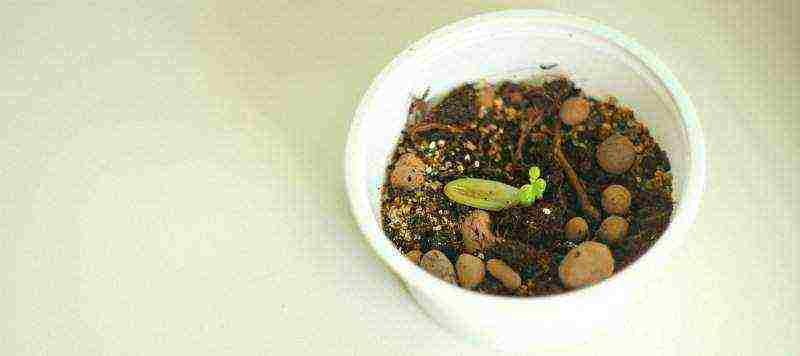 Sedum red-colored with a young shoot
Sedum red-colored with a young shoot
Video: propagation of succulents by cuttings
author Alexander Dubeykovsky, author's photo
All cactus lovers want to buy something new for their collection, something rare. Sometimes this desire is so strong that one new plant is not enough for a person - he needs two, three or four cacti of the same species. Such a number of plants makes it possible to conduct experiments on pollination, to choose a more beautiful, healthy and hardy pet for the collection. However, not all amateurs stop at such a number of plants of the same species.
Some types of cacti can amaze a grower with their appearance so much that he wants to have a lot of plants of this type.
How can this be achieved? The only answer is sowing seeds. How many wonderful plants can you get from sowing!
Let us dwell on a typical example for most cacti - sowing seeds of the Astrophytum capricorne cactus.
This is how the seedlings of Astrophytum capricorn look at the age of 9 days and at the age of one year.
From these photographs it can be seen that with the help of ordinary sowing of seeds, a cactus lover, if desired, can easily become the owner of many plants.
So, how to properly sow the seeds of cacti and most succulents?
It is important to take into account the following positions:
1. Air temperature.
2. Watering.
3. Air humidity.
4. The depth of the bowl and the thickness of the earth layer.
5. Composition of the substrate.
6. Fertilizers.
7. Fungicides and insecticides.
8. Technique of planting and watering seeds.
Let's consider these positions in detail.
1. When sowing seeds air temperature during the day it should be maintained in the range from 20 to 26 degrees. It is impossible to go beyond these boundaries (in one direction or another) even by a few degrees, otherwise the "yield" of crops will catastrophically fall. A temperature of 33 degrees will burn the tender roots of seedlings, and a temperature of 14-16 degrees will stop the development of astrophytums.
Night temperature the content of crops should be lower - about 18-20 degrees. The coolness of the night stimulates seed germination and gives the seedlings a break from active daytime growth. The vast majority of astrophytums begins to germinate 2-3 days after sowing; germination ends in 5-7 days.
Freshly harvested seeds have a very high germination rate, sometimes it reaches 110 percent. This is, of course, a joke, but it is understandable: for example, “500 seeds” is written on the packet; when the seedlings have sprung up, there may be 600 or 700 of them. This means that there was a "pleasant mistake" - there was a slightly larger amount of seeds in the bag.
2. In the first month after sowing the seeds of cacti and succulents, timely watering: do not allow the top layer of the earth to dry out for a day or more, as this will cause irreparable harm to the roots that have just formed at the surface of the substrate. Only starting from the second month I begin to gradually accustom the seedlings to the usual irrigation regime with the soil drying out in several days.
3. To keep the crops of cacti and succulents in humid air conditions, it is not necessary to contact the glass and cut out exact rectangles for bowls from it - this is an unnecessary effort and time. Necessary air humidity is achieved by covering the inoculated dishes with ordinary (thin, white and transparent) polyethylene.
4. My experience of multiple sowing of cactus and succulent seeds over several years has shown that optimal bowl depth is 6-7 cm. And, accordingly, thickness of the earth layer in a bowl should be 1-2 centimeters less and equal to 5 cm.
5. For sowing cactus and succulent seeds, I recommend the following substrate composition:
- 1 part of leaf humus (forest land from under birch, linden or hazel);
- 2 or 3 parts of sand.
The sand used to form a suitable substrate must be washed, ranging in size from 1 to 3 mm. Very fine sand (less than 0.5 mm in size) cannot be used, as it “concretes” the sown soil. And coarse sand (more than 3 mm in size) cannot be used for sowing either: on very large grains of sand (right on these "cobblestones" hot from the heat), germinating seeds have many of their small suction roots. As a result, these roots can dry out in several hours if the grower does not have time to find such seedlings and does not cover their roots with soil in time. The large amount of work on burying the roots of young seedlings into the ground is quite tedious. But if you use sand of normal size (1-3 mm) for sowing seeds of cacti and succulents, then you no longer need to bury the seedlings - their roots will find their way on their own, the seedlings will take root on their own.
6. In the first six months of growth fertilizers it is unnecessary to use for seedlings of cacti and succulents. When nitrogen fertilizers are used at this time, the volume of plants will, of course, increase, but their resistance will decrease. We draw conclusions and choose - which is more important to us: the size of the seedlings or their resistance to external factors?
7. Powder fungicides (such as garden sulfur) does not need to be used, since they create a crust on the surface of the soil, which kills delicate seedlings of cacti and succulents.
Insecticides you can use it, but only liquid and very weak concentration. Their use will reduce the activity of sciarids and other lovers of profit on a young cactus-succulent garden.
8. And another very important tip: sowing seeds is best done from a thick white sheet of paper - by gently tapping on a leaf folded in half with seeds with a thin stick or needle. This contributes to the even distribution of cactus and succulent seeds over the surface of the substrate.
Watering non-germinated seeds and small seedlings from above can only be done by spraying, since watering them in a different way, you can accidentally bury seeds and young plants, and this is contraindicated. You can apply and bottom irrigation crops.
I wish you success in growing cacti and succulents from seeds.
Alexander Dubeykovsky,
Gomel, Belarus)
Flowers and violets
All about cacti on the
Basic rules for growing succulents at home
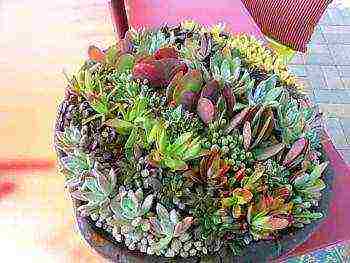 Succulents are those wonderful plants that are interesting to look at in winter, and for which you need minimal maintenance in the summer when you go to the country or on vacation. These are plants in arid places, they are unpretentious and always have an unusual appearance. Succulents include those plants in which the leaves and stems are dense, fleshy, "juicy". The most common representatives of the middle lane are cacti, agave, fat women, rejuvenated, sedum, aloe. Plants with delicate, fragile, soft shoots are not succulents.
Succulents are those wonderful plants that are interesting to look at in winter, and for which you need minimal maintenance in the summer when you go to the country or on vacation. These are plants in arid places, they are unpretentious and always have an unusual appearance. Succulents include those plants in which the leaves and stems are dense, fleshy, "juicy". The most common representatives of the middle lane are cacti, agave, fat women, rejuvenated, sedum, aloe. Plants with delicate, fragile, soft shoots are not succulents.
The main advantage of succulents over other flowers is the ability to grow in the poorest soils in the absence of moisture. Such conditions can be compared to a desert. Why is this happening? Due to the ability to accumulate moisture in leaves and shoots, these plants draw out the smallest drops of water from the soil and slowly consume them in unfavorable dry times. The root system is located close to the surface, after the soil dries out, the roots die off, and the rudiments of young roots immediately start growing when watering.A thick layer of epidermis in the stems and leaves serves as protection from the sun, which evaporates moisture from the plants.
Conditions for growing succulents and caring for them
Home-grown succulents require almost the same care conditions.
1. The soil in which succulents thrive should be light and infertile. The ideal composition would be a mixture of sand, turf and leafy soil, taken in equal proportions, or a mixture of garden soil with sand. When planting, be sure to drain with crushed coal, pebbles or expanded clay. Use a ready-made substrate only one that is intended for growing succulents, but without peat, as it retains moisture inside, which is detrimental to any succulent. Use coarse sand, do not ignite or process with potassium permanganate. If you plant succulents in pots, then in clay or plastic of a small diameter with holes in the bottom.
 2. Succulents - lovers of bright light, from this they grow well. If there is little natural light, then install additional lighting. Succulents, in which the color of shoots and leaves is dark green, are highly resistant to a lack of light, but even they will eventually start to wither and hurt. They also do not accept sudden changes from the shadow to the bright sun, burns of the leaves are possible.
2. Succulents - lovers of bright light, from this they grow well. If there is little natural light, then install additional lighting. Succulents, in which the color of shoots and leaves is dark green, are highly resistant to a lack of light, but even they will eventually start to wither and hurt. They also do not accept sudden changes from the shadow to the bright sun, burns of the leaves are possible.
3. Watering. Here, everything is extremely simple; a lack of moisture is better than an excess of it. Such plants are watered in the summer 2-3 times a week as the soil dries up, and in winter no more than 2 times per season. Pay attention when watering how the water flows through the soil, it should saturate it completely, and not go through the passages to the drainage holes. Water the succulents with soft room temperature water. Do not spray.
4. Succulents are fertilized with phosphorus-potassium fertilizer. It is better not to use nitrogen. Top dressing should be weakly concentrated and no more than 2 times a month.
5. In summer, succulents grow actively at high temperatures, making excellent compositions. In winter, it is better to lower it to 8-10 ° C, so that the plants in the warmth do not stretch out from lack of light, but stay at rest from November to March. In winter, plants are usually placed on a balcony or veranda, away from radiators.
6. How to transplant succulents. Many plants have a thorny trunk, so when transplanting it, you need to wrap it with paper, and holding on to the ends, pull the plant out, transplant it into a new pot and cover it with new earth. Do not water immediately to prevent the roots from rotting. Young specimens are transplanted every year, changing the pots to a larger size. For adult plants, once every 3 years is enough.
7. Diseases. Rot is a serious problem for succulents. When the plants are cold, the rot is fungal, and when it is warm, it is bacterial. They appear as mold or stains. Treatment consists of a surgical method, remove all damaged areas to healthy tissue and treatment with Vitaros, Fundazol, Topaz. Fitosporin as a treatment for developing rot can not cope. As a preventive measure, avoid dampness in the substrate, let it dry out to the end, so that there is no room for bacteria to develop. Succulents propagate by grafting - this is a good way to grow a new healthy plant than to have an ugly succulent shape after an illness. But there are other ways to reproduce succulents.
Succulents are installed in rooms to humidify and absorb harmful carbon dioxide. They become the center of bonsai and mini-gardens using driftwood, pebbles, wood.
